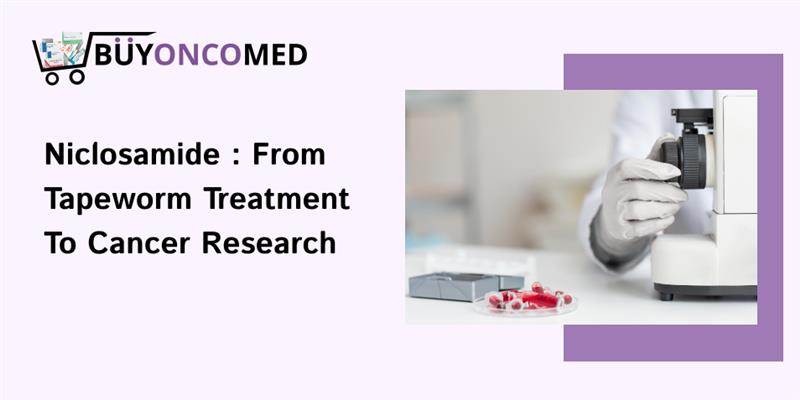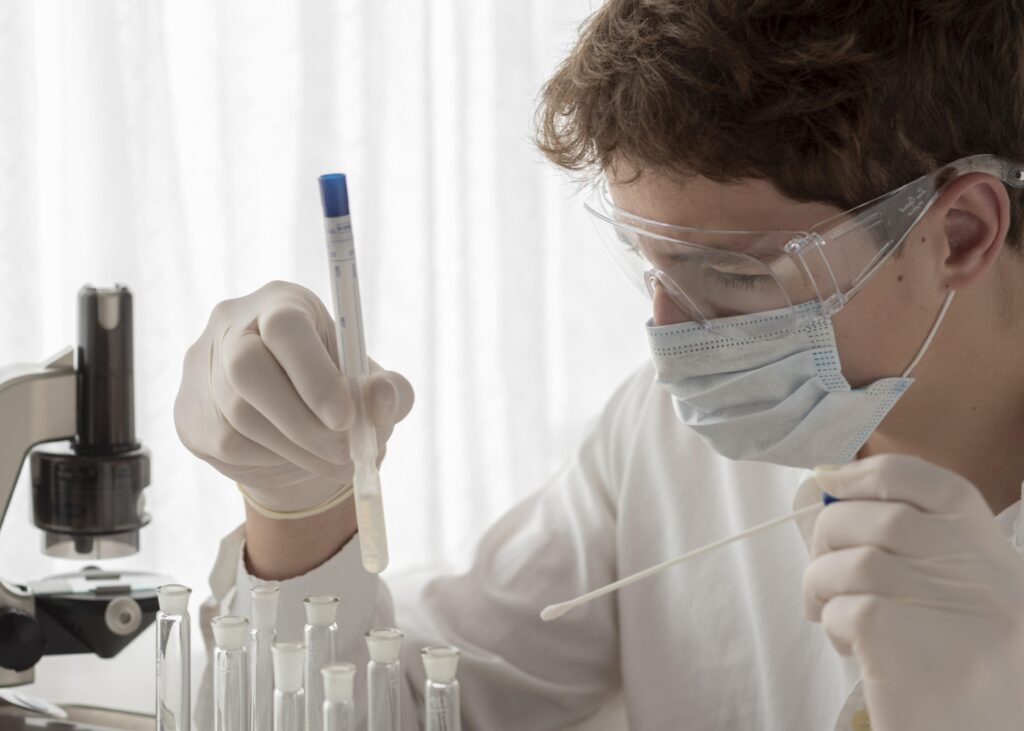
Imagine an old, trusty tool in a toolbox. You have been using it in the same line of work, and that too with much success, for years together. And, one day, you find that it is the solution to another quite different problem, which happens to be much more difficult to crack.
That’s the story of Niclosamide.
This basic medicine has been in use as a remedy for eliminating nasty tapeworm infections, over 60 years. It works, it is recognized, and it works well. However, now this old drug is under the auspices of the scientists. They also envision it as having huge war potential: the war against cancer. It is the astonishing account of a common parasite killer entering the domain of high technologies of cancer treatment.
The Original Mission: Niclosamide As An Effective Tapeworm Treatment
Before we get to the exciting new research, let’s talk about what Niclosamide is known for. Its main job has always been to fight parasitic worms.
➡️ How Niclosamide Works Against Tapeworms: A Simple Mechanism
How does a small pill take down a long tapeworm? It’s quite clever.
Conceptualize the tapeworm as a gadget that must remain plugged in at all times to survive. It gains this power by creating a unique energy molecule known as ATP. Niclosamide acts by disabling the worm’s only means of making ATP. It’s as if we’re yanking out a power cord. Without energy, the tapeworm can no longer cling to the wall of the gut, and your body can expel it as waste. It’s a precise hit that goes directly to where the worm resides: in your gut.
➡️ Approved Uses, Brands (Yomesan), And Dosage For Parasitic Infections
You may also encounter Niclosamide 500 mg as the brand name Yomesan. Several types of tapeworm infection can be treated with the drug, including beef, fish, and dwarf tapeworm.
Parasitic infections like the one featured in this clip can be a concern worldwide, particularly in regions where stream-side food preparation standards may vary. Public health in these Bangladesh or South Asia communities often would benefit from access to an effective treatment such as Niclosamide.
The dose is simple and depends on the worm and the patient’s age. It’s a proven, well-vetted medical intervention.
The Scientific Pivot: Why Researchers Are Studying Niclosamide For Cancer

So, how was a drug for intestinal worms in a cancer lab? Here’s where it gets interesting. It’s about looking at old things in new ways.
➡️ The Rise Of Drug Repurposing: Giving Old Drugs New Tricks
Researchers are always on the hunt for new ways to fight cancer. Sometimes the freshest new idea comes from a dusty old medicine cabinet. It’s a process known as “drug repurposing.”
It’s doing a drug that is safe in people and testing it on a new disease. That can save years of work and a lot of money. Researchers discovered that Niclosamide, the lowly pill used to exterminate tapeworms, had some unexpected anti-cancer properties when tested in the lab. I decided it was time to get a closer look.
➡️ Uncovering Anti-Cancer Properties: What Early Studies Revealed
In pre-lab studies, when scientists exposed cancer cells to Niclosamide, something incredible occurred. Not only did the drug slow the growth of cancer cells, but in some cases it also killed them.
This wasn’t just a fluke. It worked with various types of cancer cells in petri dishes, including colon and breast cancer. These were early glimmers of this pre-clinical work. They proved that Niclosamide might bring a potential for cancer treatment that no one foresaw
Niclosamide’s Mechanism Of Action In Cancer: A Multi-Pronged Attack
Cancer is much more complicated to defeat than a tapeworm. Cancer cells are wily, and there are myriad ways in which they can both grow and survive. What’s great about Niclosamide is that it doesn’t just do one thing; it seems to have a whole barrage of different mechanisms of action.
➡️ Disrupting Key Cancer Signaling Pathways (Wnt, mTOR, STAT3)
Cancer cells have signaling pathways that act like communication lines, telling the cells, in so many words, to grow, divide, and spread. They’re like little secret codes that help cancer to grow.
Niclosamide seems to hit multiple of these important pathways at the same time:
- Wnt Pathway: This is often a major “grow, grow, grow” signal for cancer. Niclosamide helps shut it down.
- STAT3 Pathway: This pathway helps cancer cells survive and resist treatment. Niclosamide acts as a STAT3 inhibitor, making the cells more vulnerable.
- mTOR Pathway: This is another route that tells cancer cells to grow and multiply. Niclosamide interferes with it, too.
By hitting multiple targets, the drug may stop cancer cells from easily finding a way around the treatment.
➡️ Research On Specific Cancers: Colon, Breast, Prostate, And Beyond

It’s not just general research, but research focused on some of the most common and challenging cancers. Based on lab studies, Niclosamide is a potential guard against:
- Colon Cancer
- Breast Cancer
- Prostate Cancer
- Lung Cancer
- Ovarian Cancer
It is this wide-ranging activity that has so many scientists intrigued. But working in a lab is a different task from healing a person.
The Road To The Clinic: Current Challenges And Future Outlook
For all the transformative work in the lab, the fact is, you can’t get Niclosamide as a cancer treatment today. Scientists still face some big obstacles
➡️ The Bioavailability Hurdle: Getting The Drug Where It Needs To Go
Here’s the main problem: bioavailability.
This term simply describes “how much of a drug gets into the bloodstream to do its job.” When you swallow a Niclosamide pill to kill a tapeworm, it sticks around in your gut. Great for killing a worm in one’s intestines.
But for cancer, the drug has to get out of your gut, and into your blood, so it can race through your veins to your lungs, or breast or prostate tumors. The Niclosamide standard pill is no good for this. Therefore, researchers are now intensively developing novel formulations and delivery forms to address this bioavailability issue.
➡️ An Overview Of Niclosamide Clinical Trials For Cancer
I mean, human studies are taking place. New formulations of Niclosamide are being tested in the lab to see if they are safe and work to treat cancer in people. This research is preliminary. When a new treatment is effective and safe can take a long time to prove. The role of Niclosamide in cancer management is unquestionably limited to the outcome of these active trials.
Safety Profile: Understanding Niclosamide’s Side Effects
Niclosamide is considered relatively safe for tapeworms. There are also generally mild side effects, such as nausea or abdominal pain. And that’s because so little of the drug is absorbed into the body.
For use in cancer treatment, the doses are all but certain to be larger, and the drug would need to be taken up by the entire body. That means the side effects could be different. These new formulations is a primary endpoint of the current clinical trials.
Conclusion: The Dual Legacy Of An Old Drug with New Promise
Niclosamide has two stories. One is the well-documented record of an effective medicine that has helped people for years. The other is the exciting, but still unwritten, tale of its possible future as a weapon against cancer.
It is a moving demonstration of how scientific curiosity can be the key to uncovering incredible new possibilities in the most unlikely of places. As we look to researchers to do their job, perhaps the tale of Niclosamide has given us a good look at the digital future of medicine.
Frequently Asked Questions (FAQs)
1. Is Niclosamide Approved For Cancer Treatment In Humans?
No. As of now, niclosamide is only approved by medical authorities, including the FDA, for the treatment of parasitic worm infections. And its role in cancer is still experimental and confined to clinical trials.
2. How Does Niclosamide Kill Tapeworms But Not Human Cells (At Normal Doses)?
It disrupts the tapeworm’s energy-generating mechanisms. Because the drug isn’t easily absorbed by the gut, it wallops the worm itself with little of the substance ending up in the person’s system, making it selectively toxic to the parasite.
3. What Makes Niclosamide A Promising Candidate For Cancer Therapy?
Its ability to hit multiple cancer-driving pathways simultaneously (e.g., Wnt, STAT3, and TOR) makes it an attractive contender. This might make it more difficult for the cancer to become resistant.
4. Can I Buy Yomesan (Niclosamide) Online To Use For Cancer?
You should not do this. Regular pills are not designed to be effective in treating cancer throughout the body, and playing Doctor to yourself is very dangerous. Always talk to a doctor before beginning a treatment program.
5. What Is The Biggest Challenge In Repurposing Niclosamide For Cancer?
Its major obstacle is its low bioavailability. Scientists will have to come up with a new way to formulate the drug so that it can be absorbed by the body and delivered to tumors before it can be an effective treatment for cancer.

